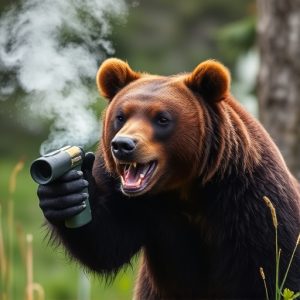Optimizing Bear Spray Protection: Quick Holster Systems and Effective Range
The optimal distance for bear spray to be effective is 20-30 feet (6-9 meters), allowing users to cr…….
The optimal distance for bear spray to be effective is 20-30 feet (6-9 meters), allowing users to create a protective barrier without close contact with bears. Wind conditions, topography, and vegetation density impact the spray's reach, with calm or light winds aiding distribution while stronger winds can cause deviation. Quick release holster systems ensure immediate access for defense against bears in unpredictable wilderness settings. Regular training and understanding local bear behavior are crucial for maximizing the effectiveness of bear spray within this optimal distance range.
Discover the ultimate defense against bear encounters with a bear spray quick release holster system. This comprehensive guide explores the science behind bear spray effectiveness, focusing on the crucial factor of range. We delve into how quick-release holsters enhance accessibility and survival chances in the wild. Understanding the optimal distance for maximum protection, along with factors influencing spray distribution, equips outdoor enthusiasts to make informed decisions. Uncover the secrets to maximizing your safety in bear country.
- Understanding Bear Spray Range and Effectiveness
- The Role of Quick Release Holster Systems
- Factors Affecting Spray Distribution and Impact
- Choosing the Optimal Distance for Maximum Protection
Understanding Bear Spray Range and Effectiveness
Bear spray is an effective self-defense tool against bears, but understanding its range and effectiveness is crucial for safe wilderness travel. The best distance for bear spray to be effective varies depending on several factors, including the type of spray, wind conditions, and the bear’s behavior. Typically, experts recommend aiming for a distance of 20 to 30 feet (6 to 9 meters) when using bear spray. This range allows for accurate application while providing enough space to avoid immediate close-range contact with the bear.
At this optimal distance, bear spray can create a barrier of capsaicin, the active ingredient, that irritates the bear’s eyes and respiratory system. This irritation disorients and often causes the bear to flee. However, it’s important to remember that wind direction and speed can significantly impact the spray’s effectiveness. Downwind conditions might reduce the reach and potency of the spray, while upwind conditions could blow the spray back towards the user. Therefore, choosing a location with minimal wind or being prepared to adjust one’s position accordingly is essential for maximizing the bear spray’s range and effectiveness.
The Role of Quick Release Holster Systems
Bear spray is a powerful self-defense tool designed to deter aggressive bears, but its effectiveness depends on proper deployment and accessibility. Here’s where quick release holster systems come into play. These innovative devices are engineered to provide immediate access to bear spray during encounters, ensuring it’s within reach when you need it most.
The best distance for bear spray effectiveness is approximately 20-30 feet (6-9 meters), making quick release holsters crucial for maximizing its reach and impact. By allowing users to readily deploy the spray with just a flick of a thumb or a simple trigger pull, these systems enable individuals to defend themselves against bears from safe distances. This rapid deployment capability is particularly valuable in unpredictable wilderness settings where seconds can mean the difference between safety and an attack.
Factors Affecting Spray Distribution and Impact
The effectiveness of bear spray is significantly influenced by several factors, with distance being a crucial one. The best distance for optimal bear spray effectiveness is generally considered to be around 20-30 feet (6-9 meters), though this can vary depending on various conditions. At this range, the spray can create a barrier that discourages bears from approaching further, providing valuable time for escape or retreat.
Beyond distance, wind direction and speed play a critical role in spray distribution. A calm or light breeze is ideal as it helps to spread the spray evenly across the intended area. Stronger winds can cause the spray to drift away from its target, reducing its impact. Additionally, factors like terrain elevation and vegetation density can affect how far and wide the spray reaches, requiring users to consider their surroundings when deploying the spray.
Choosing the Optimal Distance for Maximum Protection
When considering a bear spray quick release holster system, one crucial aspect to evaluate is the optimal distance for maximum protection. The best distance for bear spray effectiveness varies based on several factors, including the type of bear and its behavior. Generally, aiming for a distance of 20-30 feet (6-9 meters) provides a safe buffer while ensuring the spray reaches the bear effectively. This range allows users to disrupt an approaching bear’s path without increasing the risk of direct contact or further aggression.
For optimal results, it’s essential to remember that practice and familiarity with your gear are key. Regular training in deploying the bear spray from various positions and distances will help ensure its effectiveness when needed. Additionally, understanding local bear behavior patterns can aid in gauging the best distance, as certain species or individuals may require adjustments to this standard range for maximum protection.
Bear spray is an effective deterrent, but understanding its range and optimal deployment is key. By choosing the best distance for maximum protection, combining it with a quick release holster system, and considering factors like spray distribution, you can enhance your safety in bear country. Remember, knowing how to use bear spray responsibly and effectively can make all the difference during encounters with these majestic yet potentially dangerous animals.


